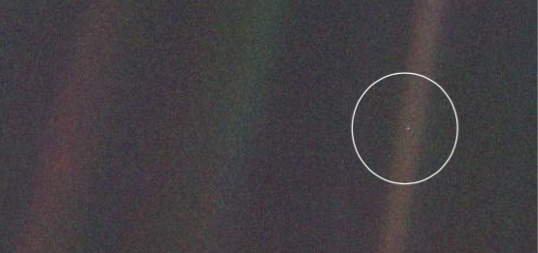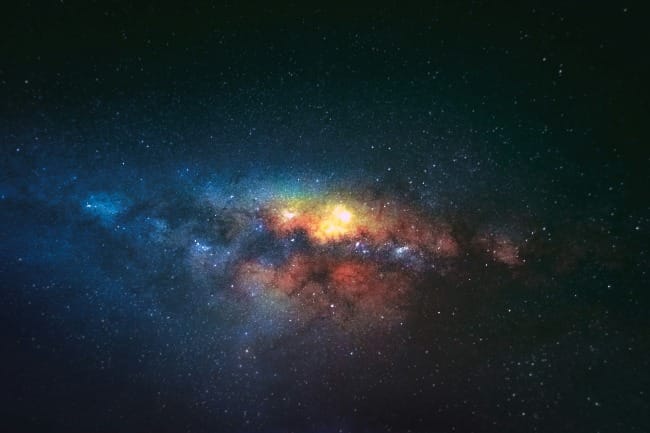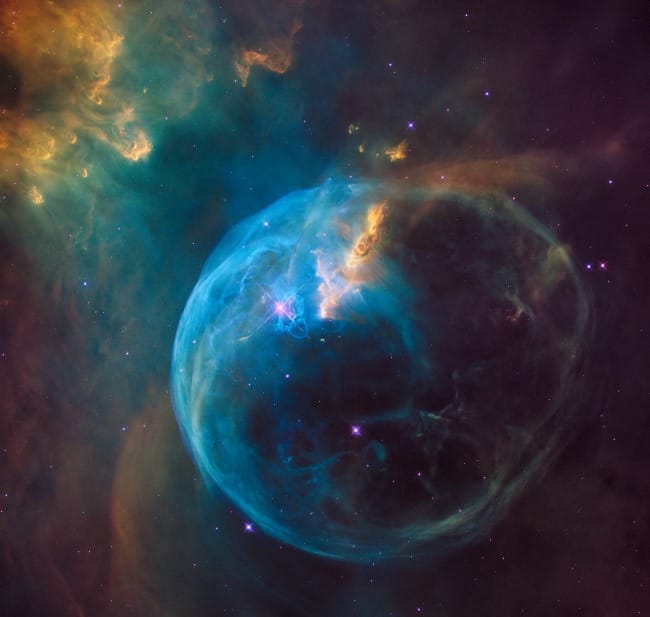In my last column, I (re)introduced seven shifts that Christians need to make in order to develop a more ecologically conscious discipleship. The next seven columns will explore each of these shifts in more depth. This first one looks at the need to shift our cosmology. In the scientific world, cosmology is a branch of astronomy concerned with the origin and evolution of the universe. In the more popular sense, which I am using here, cosmology is the definitions, patterns, and meanings we give to the universe and our place within it.
All individuals and cultures have a cosmology; often there are several cosmologies at work, complementing or competing with each other. For instance, many of us draw upon scientific and religious cosmologies to describe reality and prescribe how we should live within that reality. Cosmologies are powerful, but they are not set in stone; they can shift dramatically when new discoveries are made or new perspectives are needed.
Just A Pale Blue Dot?
In the modern era, scientific cosmologies have profoundly influenced our self-understanding. For hundreds of years, science and religion agreed that the earth was the center of the universe. This began to shift in the sixteenth and seventeenth centuries, when astronomical observations by scientists such as Nicolas Copernicus and Galileo Galilei led to the conclusion that the earth orbited around the Sun.
As our knowledge of the universe has continued to expand, so has our sense that we are far from the center of it all. One key moment in this reimagining came in 1991. As the Voyager 1 spacecraft hurtled away from our solar system, it turned its camera back towards earth and snapped a picture from four billion miles away.

Earth appeared as a tiny point of light in the center of scattered light rays from the Sun. In his 1994 book Pale Blue Dot, influential astronomer Carl Sagan wrote the following:
“Look again at that dot. That's here. That's home. That's us. On it everyone you love, everyone you know, everyone you ever heard of, every human being who ever was, lived out their lives. The aggregate of our joy and suffering, thousands of confident religions, ideologies, and economic doctrines, every hunter and forager, every hero and coward, every creator and destroyer of civilization, every king and peasant, every young couple in love, every mother and father, hopeful child, inventor and explorer, every teacher of morals, every corrupt politician, every "superstar," every "supreme leader," every saint and sinner in the history of our species lived there—on a mote of dust suspended in a sunbeam.... Our planet is a lonely speck in the great enveloping cosmic dark. In our obscurity, in all this vastness, there is no hint that help will come from elsewhere to save us from ourselves.”
Sagan’s cosmological observations, along with the famous image that goes along with it, have had a profound influence on how humans interpret the universe and live their lives within it. I often find myself in awe of these discoveries, struggling to understand the vast expanses of interstellar space and the fragility (miracle?) of our existence. I cannot help but ask, "What does it mean to live on a "pale blue dot" within a unfathomably vast universe?"
Even though modern science is not set up to answer such a question, Sagan can't help step outside the boundaries of his field to offer his opinion. I find it very interesting that he turns to evocative ("mote of dust") and emotional ("lonely speck") language to describe the earth, and concludes his description with an ethical observation: "there is no hint that help will come from elsewhere to save us from ourselves."
Many people have embraced Sagan's interpretive cosmology, even though it raises all sorts of questions. What moral and ethical conclusions can be drawn from our understanding of the physical vastness of space? What role do awe and wonder play in our expanding knowledge of the cosmos? What does it mean to say that our planet is "lonely"? Sagan's book is about solving human problems, but is there anything in his cosmology that would prevent people from embracing nihilism? How does this cosmology help us identify and address the problems we face? And is there truly "no hint that help will come from elsewhere to save us from ourselves?" Scientific cosmologies can only take us so far.
Perhaps the reason that so many look to scientific explanations of the cosmos for meaning is that alternative, complementary cosmologies have proved deficient. And this includes Christianity.
The Poor State of Christian Cosmology
Religious cosmologies are focused on understanding, interpreting, and integrating a divine or spiritual reality to the universe. When Christians talk about their cosmology, most begin with Genesis 1 and 2, the cosmological origin stories that describe how God created “the heavens and the earth.” Most, however, quickly move past creation to God's work to redeem people through the people of Israel, Jesus, and the Church. This divorces creation from redemption in a decidedly unbiblical way, and reduces the physical world to a set of resources meant to temporarily meet our needs while we pursue higher, “spiritual” goals. It is a cosmology with very little interest in the world as it is or as it may be. This is sad, uninspiring, and as ethically ambiguous as Sagan's framework. Fortunately, there is so much more to it that that!
My understanding of creation has been deepened significantly by Old Testament scholar Terence Fretheim, particularly his book God and World in the Old Testament: A Relational Theology of Creation. Among countless gems of scholarship and wisdom, Fretheim has helped me to see at least three aspects of God’s creative work that can help us make the shift towards a more robust, inspiring, and dynamic cosmology.

1: Originating Creation
This is what most of us think about when we hear the word ‘creation.’ We recognize God as the origin of everything, and we imagine stars and planets whirling into being, the earth taking shape, and life emerging in increasing diversity and complexity. What we often overlook is how many elements of creation are given a task: the sun and moon are to govern the day and night; the land is to produce vegetation, the creatures of the sea and the birds are to “be fruitful and multiply” (it’s not just humans!). We are not the center of it all.
We also see that God did not create a world that was completely finished, or perfect. It was meant to go somewhere, to change and grow, with every feature and every creature having a part to play. That is the world into which the human creature comes into being and is given the particular vocation to represent and partner with God as servant-rulers of the earth (more on that in later posts).
The originating act of creation is much more complex and diverse than most Christians think, and it is only the beginning of how we should think about creation.
2: Continuing Creation
Creation is not just a noun that calls to mind an event in the past, it is also a verb that describes God’s ongoing activity and presence in a world that moves forward through a mysterious combination of divine will and creaturely freedom. New forms of life continue to appear – creation is ongoing! The world continues to be shaped by choices made by creatures – especially humans. Sometimes God lets things play out and sometimes God intervenes dramatically. The Bible shows us that God is committed to enhancing the life of the world, even when humans (the very creatures he created to partner in the process) rebel and work against God’s desire. You and I are in the midst of this great drama; as we will see, there is an ending in mind, but the role that you and I play right now is up to us.
3: Completing Creation
God’s work of creation is pointed towards bringing a new heaven and earth into being. The Bible pictures this as neither a return to an original, pristine state, nor a complete undoing of what we currently experience. It is a picture that contains both continuity with the past and something genuinely new which does not yet exist. This is why texts such as Isaiah 65-66 and Revelation 21-22 speak in figural, visionary language. It is clear that the new creation will be bodily and earthly, but in ways that exclude the forces of sin and death that haunt our current existence.
This is why it is important to see that Jesus is the originator of the new creation. In his life, death, and resurrection, we are given glimpses of where the whole creation is headed. The Greek text of John 3:16 says, “For God so loved the cosmos, that he sent his only begotten Son.” Paul wrote in 1 Corinthians 5:17, “If anyone is in Christ, the new creation has come!”

Cosmological Integration
Our scientific and religious cosmologies can live in creative tension with one another. Are we living on a beautiful pale blue dot floating through an unfathomable expanse? Yes. Does this mean we are insignificant and alone, with no one to help us figure out what it means to float alone through the darkness? No. Christians can receive (and add to) the growing body of knowledge about the universe with awe, wonder, and curiosity, while also seeing the Creator at work behind, before, within, without, and ahead of all that is and will be.
That is a cosmology worth considering.
With you on the Way,
James